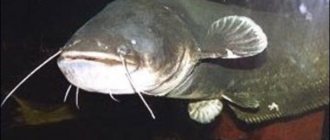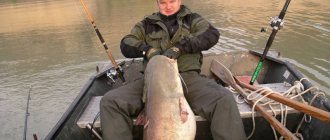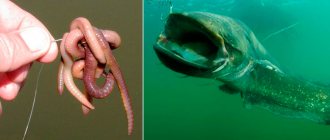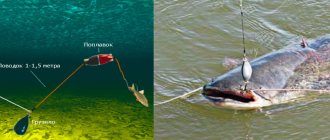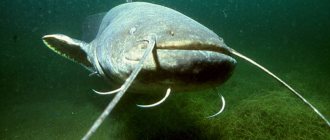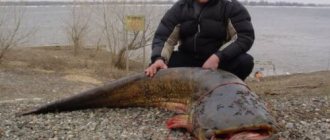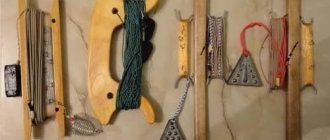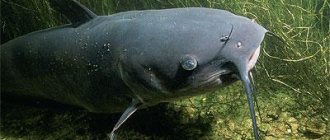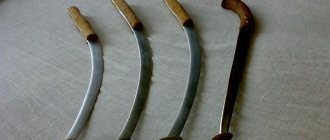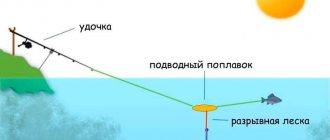Habits of catfish
Catfish is a freshwater fish, found throughout the European part of Russia. The meat is very tasty in fish weighing up to 10 kg. Larger fish are considered old, and the meat has a noticeable muddy taste. Catfish fishing stands out among fishermen as a separate area.
Catfish live in rivers and lakes, preferring holes and piles of snags. He is a scavenger and can hunt successfully if necessary. Thanks to its large mouth, it is able to swallow large animals, such as birds or muskrats. The jaws have several rows of small teeth, resembling a grater, and directed inside the mouth.
The upper jaw of the catfish deserves special attention, since it consists of a fixed, fairly strong and even inside bony shield, which a fishing hook is practically unable to penetrate in a fish weighing over 2 kg. One of the most common reasons for catfish falling off the tackle is the hook slipping across the sky.
Catfish hunt most often at night; there are often cases when bites occur during hot lunch hours. Favorable fishing times in summer are 23:00 - 03:00 and 06:00 - 08:00. Depending on the temperature of the air, water and daylight hours, these limits may vary.
Weighing catfish
Types of catfish in Russia
In Russia, Europe and Asia, the most common catfish is the common catfish, familiar to most fishermen by its wide head with a large mouth. This is one of the largest species, growing more than 2 meters in length.
American catfish are often found in southern Russia. It differs from the ordinary one by its head narrowed towards the nose and light coloring. A distinctive feature is that the first ray of the dorsal and pectoral fins is a strong and sharp jagged bone, the prick of which is very painful and leads to rapid swelling of the limb. American catfish are relatively small and grow up to 1 meter long.
Catfish habitats
The American catfish tolerates strong currents more easily, so it can be found in stormy canals and rivers, while the common catfish feels better in calm water.
In cases where fishing is carried out from the shore, trying to catch a catfish under a snag is ineffective. In case of danger, the fish immediately goes deep into the trunks and branches, which is likely to allow it to tear off even the strongest gear. You should choose places with holes that, with a certain skill, can be seen visually in the current. The cast is made to the upstream edge of the pit.
Fishing in snags is best used with a boat and an echo sounder, when the fisherman is mobile and does not allow the fish to tangle the tackle, even to the point of using forceful fishing.
There are several tricks for determining the presence of catfish in a pond area.
- Frog. These amphibians instantly detect the presence of catfish in the water. It is better to catch the frog in advance and simply throw it into the water in the place where you are going to catch it. If it, smoothly moving its paws, calmly remains on the surface or hides in the depths, the catfish is not nearby at the moment. Otherwise, the frog very quickly runs away from the water to the shore, creating a lot of noise and the impression of panic.
- Fry. Playing fish (except for splashes due to predator hunting) and fry in the coastal zone are indicators that there are no catfish in this hole. However, at night he may well come to this place to hunt; if you find a deep hole, consider whether it is worth looking for another place for fishing.
Catching catfish
Fishing place
Where to catch catfish? Which sections of the river are the most promising? First of all, you should pay attention to places with natural barriers that create a reverse current.
Such whirlpools are very attractive to the river giant. He also likes great depths behind artificial barriers (dams, dams, bridges). You can throw gear from the shore by moving 50-70 meters away from it downstream.
Experienced fishermen say that on a warm, clear night, catfish are excellently caught on sandbanks near the shore. True, in this case, small individuals predominate in the catches; catching a large catfish in such a place is purely an accident.
Bait and tackle for catching catfish
Now that the fishing location has been chosen, let's look at how catfish are caught.
Tackle Tips:
- Catfish is a strong fish. The fishing rod should be durable and not long; for example, the author uses inexpensive Crocodile fishing rods with a length of no more than 2.15 meters.
- The reel must withstand heavy loads, have a reliable friction clutch, which should not be weakened at the time of fishing.
- When fishing with bottom tackle, you should check the strength of the fishing rod in the stand several times - a catfish bite can often turn it out of the ground and carry the fishing rod into the pond.
- The fishing line must have an appropriate test, even if you do not plan to catch a large specimen. As practice shows, it makes no sense to take fishing line with a test weight of less than 16 kg.
Very often, bottom equipment is used, tied so that the hook or tee with bait is located below the level of the weight and can lie on the bottom.
Catfish rig
Now let's look at bait options for catching catfish. There are two basic principles: the bait must have a strong smell or be mobile.
- Meat burned over an open fire. Most often, it is a sparrow fried with feathers. But it can be any other piece of meat or small animal: mouse, frog, chicken.
- Raw meat containing blood. An excellent bait for catfish is a bird's heart, and in small currents, an animal's liver. Once the plume of blood is no longer released into the water, the bait loses most of its effectiveness.
- Pieces of freshly caught fish. It is better to take the head - it releases a large amount of blood into the water, and the gills have a specific smell that can attract catfish.
- Bunch of worms. For such bait it is better to use a tee. Crawlings are used - the thicker the better. They are fitted with an accordion onto all three hooks of the tee. The peculiarity is that the moving tips will certainly remain. The catfish has special areas on the surface of its body that allow it to feel the slightest vibrations of the water around it.
- Live bait. As already mentioned, catfish do not necessarily feed on carrion, so they may well be attracted to live fish. Only the bait must be mounted correctly, and the leash must be of sufficient length so that the fish has freedom of movement. In the lower reaches of the Kuban, on floods, for example, catfish are caught by hanging a simple tackle with live bait and a weight on the branches of a tree bending over the water.
- Little frog. It is not effective to take a large frog for such bait, but a frog with a body length of no more than 5 cm (excluding legs) is quite suitable. In many regions, this is a favorite delicacy for catfish. You should place such bait on the hook very carefully. You can hook the amphibian by the nostril, but the best way is under the sacral spine, as close to the bone as possible, so as not to damage the internal organs. It is very easy to determine whether the frog is mounted correctly: you need to place it on a flat surface. If he sits as usual, as if there is no hook in him, or even better, tries to jump, then he will live in the water for at least an hour, you just need to remember to get him out to breathe.
In this case, it is better to use a single hook; it will not interfere with the amphibian sitting calmly on the bottom in a natural position or moving under water, attracting the smell and movement of the catfish. Sometimes frogs are hooked by the hind legs, passing the hook under the muscles of the inner thigh along the bone of first one leg, then the other. But this method greatly limits the mobility of the bait.
There is a theory about catching catfish using a piece of old unscented laundry soap, like the one that was sold in the USSR. Theoretically, this method can take place, since animal fat of the worst quality is used to make such soap. However, the author has neither tested this method of fishing nor observed its effectiveness with his own eyes.
What to use to catch catfish?
Catfish is a fish for which you can experiment with baits. Fishermen try to catch it using May beetles, grasshoppers, cabbage worms, locusts, tadpoles and other living creatures, and often such experiments turn out to be successful. When catching a large catfish on a large hook, in addition to the above-mentioned frogs and live bait, you can put fried poultry (crow, sparrow, etc.), fish offal, crayfish neck, because the catfish is not picky about food during the feeding period. If you attach the most popular animal bait - a worm, then you must attach not just one worm, but a bunch of the thickest, well-fed worms.
Throws and “kwok” for catfish
L.P. Sabaneev wrote that zakidushki and “kwok” are the most reliable fishing tools for successfully catching catfish. The writer called the “kwok” a squabble, and the process itself a squabble. According to Sabaneev’s advice, if a fisherman wants to catch a giant, he should use a fishing line no thinner than 0.8 millimeters, but a nylon cord is even better. For catching large catfish, hooks from No. 16 to No. 20 have long been used, and for catching giant catfish, hooks from No. 30 to No. 40, made of steel wire, have been used.
Catching catfish using girders
When fishing with girders, there is a risk that a predator will unwind the line from the spear and drag it into the snags, and then there is no way to pull the catfish out of the shelter, where it will remain sitting with the hook in its mouth. Although there have been cases when catfish after a while crawled out of snags into a clean place. Therefore, on the Volga, where especially large catfish are found, girders are almost never used as a fishing tool.
Poke fishing
Fishing for catfish “by poke” is a simplified and therefore more reliable method of fishing with a pole. A poke is a flexible and large pole that is driven to the bottom of the river; a thick fishing line is inserted into the slot so that there is a maximum of three meters of movement. The catfish will get hooked and will resist, rushing around the pole. And even if the fish manages to pull out the poke, the cord fixed on the shore will not let the river inhabitant go far into the snags, from where there is little chance of getting it. Despite the apparent simplicity of this gear, Volga fishermen managed to catch a lot of qualifying catfish “with a poke”.
Catching catfish on a log
Catching catfish “on a log” is successful fishing with fairly simple gear. The log lies on the surface of the water on an anchor connected by a strong rope and serves instead of a float. A two-meter leash is attached to the log, on which a live bait weighing half a kilo hangs on a large hook. The catfish grabs the tasty bait and begins to drag the log float until it gets tired. And after hours, pulling out a very exhausted and exhausted catfish will no longer be difficult. And instead of a log, Ural fishermen use a barrel as a float, which is one-third filled with water and hermetically sealed, and a thick cord with a leash is wound around the barrel.
But these methods of catching catfish are not sporting because of their passivity. After all, the fisherman sets up the gear and sits at home, waiting for the catch, then comes to the pond and takes the catch. But there is one more interesting way of catching catfish, which is active and adventurous. This method has the character characteristics of catfish. They are attracted to sounds that resemble “kwok”. This method of fishing does not require special art and skills, so the army of fishermen is growing from year to year. What is the essence of this fishing? Why does the catfish follow such a sound? There is no exact answer. Most lovers of water recreation believe that the catfish are being deceived, because the sound reminds them of a frog croaking, and as we already know, frogs are a favorite delicacy for catfish. Other fishermen believe that the “croaking” for catfish is reminiscent of the sounds these fish make during mating games.
Fishing with wobblers
Submersible wobblers have also proven themselves to be effective when fishing for catfish at night. Their characteristic movements in the lower layers of water attract catfish. When night fishing on moonlit nights, it is better to do without a flashlight at all, and, if you still need one, try to keep the light on the water to a minimum. Also, it is better to study the bottom topography in the light of day in the places where you plan to use the wobbler in order to avoid unexpected snags, which are much more difficult to deal with in the dark.
Catfish are capable of hunting on the surface, so sometimes on summer nights other types of wobblers can work on especially fish-rich reservoirs, but the deep-diving one remains the most effective.
Catching catfish using kwok
One of the oldest methods of catching catfish is kwok. It is used only from a boat, and is a wooden or metal structure resembling an animal’s hoof. The fisherman rhythmically, with a break of 8–10 seconds, hits the water with it, creating a characteristic sound, while in the water column, approximately halfway between the bottom and the surface, a hook with bait is located.
It is almost impossible to learn how to kwok from descriptions or online materials, so, if desired, it is better to ask fishermen who already know how to make such a sound to teach.
When pulling a catfish ashore, there is one more little secret: if the fish is struggling strongly just under the shore, and there is a fear that it is about to tear off the tackle, if possible, you can grab it by the lower jaw. This instantly calms the prey and makes it possible to pull it ashore. But it’s better to do this with gloves: catfish teeth can leave deep and difficult-to-heal abrasions.
Catching catfish at night is one of the most exciting types of fishing. With it, you shouldn’t expect an intense bite; often there is only one bite the whole night, but the caught fish is remembered for a long time. Careful observance of the subtleties, experience and patience, as in any type of fishing, are the key to success.
Tackle for catfish
Remember the most important thing is that the tackle for catfish must be proven, very powerful and durable.
At the moment when it sticks to the bottom, it can only be moved from its place with a powerful fishing rod, and of course a power reel of size 4000-6000 according to the diving classification.
As the main fishing line, I use a cord with a diameter of 0.2 according to the Japanese classification. This is quite enough to pull a large river inhabitant weighing 8-10 kilograms ashore.
Now let's talk in more detail about the gear. How to choose the right gear and not make a mistake? Let's talk about this now.
How to choose a spinning rod for catfish?
As was previously said, when fishing for catfish, spinning rods must withstand heavy loads. The most important thing in this situation is to choose the normal limit in the test of the rod, and what is also important is the structure of the blank.
A lot depends on the structure. An excessively rigid rod can lead to fish disappearing, but a moderately parabolic action allows us to preserve the catch and bring it to the shore or boat.
A spinning rod must have a powerful butt and a flexible tip; only then will we be confident that we will be able to lift the catfish from the depths. It is advisable if the stick has large passage rings. The line comes off easily from large guides and they are usually strong.
How to choose a reel for catfish?
The requirements for a reel are even more stringent than for a spinning rod:
Firstly, you need good smoothness and a complete absence of backlash;
Secondly, you will need a large spool and a powerful friction brake;
Well, thirdly, a low gear ratio, say 4:2:1, only then will the tackle be balanced and reliable.
Which braid should you choose?
Braided line experiences the most stress throughout the entire fishing trip. From personal experience I will say that I have tried a lot of cords.
But for the last 3 years I’ve been fishing exclusively with 8-strand ones. They have zero elongation and high sensitivity, plus such cords are resistant to abrasion.
And, if we take into account that the fishing will be carried out on the bottom, where there is a lot of snags, shells and other things, then the cord will gradually wear out, and at one point it can break even on a small fish.
Catfish do not have such large teeth as pike, but with normal effort they can grind the braid, so you should not give up the leash.
An ordinary string would be out of place here, but a titanium leash with a reliable swivel and clasp is just right!
What is lipgrip used for?
And finally, the last question, which is technical, is lipgrip. If you can call it a device, then consider it that way. In short, this device is designed to grab large-sized fish by the mouth.
It’s hard to lift a catfish with your bare hands and no landing nets will work here, but the lipgrip can withstand heavy loads.
Take note of this, and if you don’t have it, I strongly recommend that you buy it, and life will become easier!
